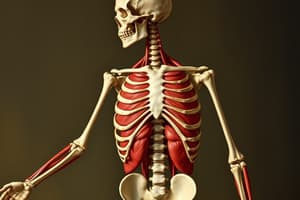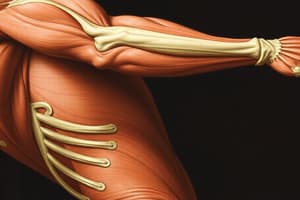Podcast
Questions and Answers
What are the main components of the musculoskeletal system?
What are the main components of the musculoskeletal system?
Bones, joints, and muscles
Which type of muscle tissue is responsible for pumping blood?
Which type of muscle tissue is responsible for pumping blood?
- Skeletal muscle
- Smooth muscle
- Cardiac muscle (correct)
- Connective tissue
Skeletal muscles can be controlled voluntarily.
Skeletal muscles can be controlled voluntarily.
True (A)
What percentage of human body weight do skeletal muscles comprise?
What percentage of human body weight do skeletal muscles comprise?
The primary function of the musculoskeletal system is to provide ______.
The primary function of the musculoskeletal system is to provide ______.
How many types of muscle contraction are there?
How many types of muscle contraction are there?
What are the names of the three types of muscle contraction?
What are the names of the three types of muscle contraction?
What tissue connects skeletal muscles to bones?
What tissue connects skeletal muscles to bones?
Cardiac muscle is considered to be [blank].
Cardiac muscle is considered to be [blank].
Flashcards are hidden until you start studying
Study Notes
Musculoskeletal System - Components and Functions
- The musculoskeletal system is composed of bones, joints, and muscles.
- It provides form, support, and stability to the body, enabling movement.
Types of Muscle Tissue
- Skeletal muscle: Voluntary control, attached to bones, makes up 30-40% of body weight, striated appearance under microscope.
- Smooth muscle: Involuntary control, found in internal organs (blood vessels, hair follicles, digestive tract), contracts slower but for longer durations.
- Cardiac muscle: Involuntary control, exclusively found in the heart, responsible for pumping blood throughout the body.
Functions of the Musculoskeletal System
- Supports the body and keeps it upright.
- Enables movement.
- Protects internal organs.
- Stores calcium, phosphorus, and blood components.
Muscle Contraction Types
- Concentric contraction: Muscle shortens.
- Eccentric contraction: Muscle lengthens.
- Isometric contraction: Muscle remains static, no length change.
Naming Skeletal Muscles
- Muscle names are based on their action, location, shape, fiber direction, number of divisions/heads, or attachment points.
Studying That Suits You
Use AI to generate personalized quizzes and flashcards to suit your learning preferences.




